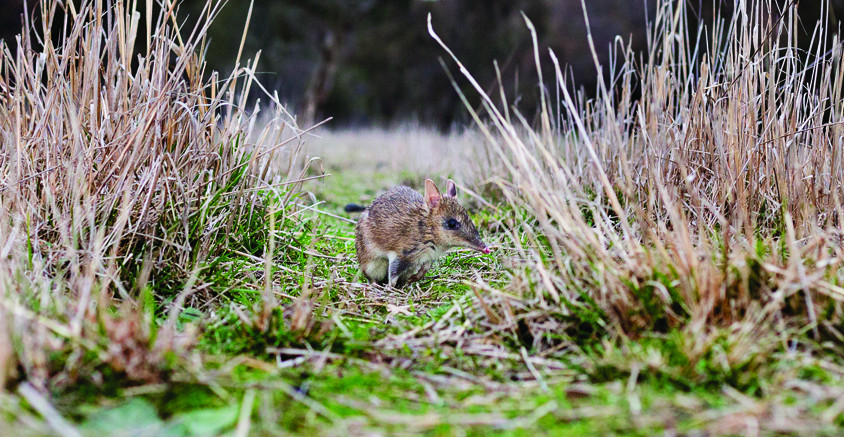Once common throughout Victoria’s volcanic plains and grasslands, the eastern barred bandicoot (EBB for short or, more scientifically, Perameles gunnii) is now one of our most endangered species and is currently considered ‘extinct in the wild’.
The utilisation and consequent destruction of more than 99 per cent of its native grassland habitat has wreaked havoc on bandicoot populations, while further pressures such as predation from foxes, cats and dogs, as well as competition with rabbits has compounded the problem. As a result, the survival of these shy, tussock-dwelling marsupials now depends on captive breeding programs and securing suitably healthy, predator-free habitats.
Although bandicoots are considered extinct in the wild in Victoria, the increasing success of breeding programs in zoos and wildlife sanctuaries means there is a need for a larger, predator-proof habitat that bandicoots can breed and flourish in. In 2013, the eastern barred bandicoot recovery project released 47 of these critically endangered bandicoots into the newly protected and restored habitat of Woodlands Historic Park in Greenvale, Victoria. These bandicoots were selected from a variety of wildlife parks throughout Victoria to ensure genetic diversity and prior to their release they underwent a specific rehabilitation program to ensure their ability to survive outdoors.
Richard Hill, senior biodiversity officer with the Department of Environment, Land, Water and Planning is also chair of the eastern barred bandicoot recovery team. Other members of this team include Parks Victoria, Conservation Volunteers Australia, Mount Rothwell Conservation Centre, Zoos Victoria and the National Trust. Working together at Woodlands Historic Park, these organisations have secured areas where bandicoots can flourish, while also setting up important monitoring programs in other locations, such as Hamilton, Victoria.
According to Hill, eastern barred bandicoots have “an amazing natural history.”
“They are one of the fastest breeding mammals on earth, capable of having up to five litters of up to five young (but usually two or three) every year of their short lives. Despite this, they are one of Victoria’s rarest mammals.”
Even once a suitable habitat has been found, the bandicoots will remain extremely vulnerable to foxes, so a large amount of the work performed at Woodlands is committed to keeping these ferals out.

Having been weighed and general condition notes taken, individuals are released in the same place they were trapped just a few hours before.
“It’s the third feral-predator free site we have established for the eastern barred bandicoot and we hope it will support a population of up to 500 within another couple of years,” Hill says. “We have set a target of 2,500 individuals to secure the conservation of this species.”
Enclosing the eastern barred bandicoots’ habitat is an all-important predator-proof fence is tall to prevent cats and foxes climbing over. Volunteers carry out ongoing border patrols and fence maintenance around the seven-kilometre perimeter to prevent breaches resulting from animals digging under it or branches falling onto it.
Since the initial release in 2013, the bandicoot population at Woodlands appears to be thriving. The recovery team commit to twice-yearly trapping sessions in order to gain some understanding of the population size and health.
According to CVA’s eastern barred bandicoot project officer Travis Scicchitano, the result of these surveys shows that the Woodlands project is working, with each new trapping session indicating an ever-flourishing population of bandicoots present.
“This July, we caught a total of 114 eastern barred bandicoots, with 46 of these being new animals we’d not trapped before. Even better, 94 per cent of the females we found showed signs of recent breeding activities.”
Madeline Townsend is the director of volunteer and membership services for Conservation Volunteers Australia – an organisation that connects volunteers with critical conservation and wildlife projects.
This article first appeared in Wild issue 149. To receive your own copy, subscribe today.



